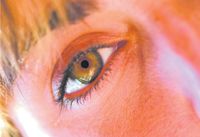Article
Transient monocular visual loss exam must be thorough
Salt Lake City—Transient monocular visual loss, amaurosis fugax, is a common complaint that ophthalmologists encounter. The challenge for the ophthalmologist is to determine if the cause is benign or of a more serious vascular origin. Kathleen Digre, MD, described the step-by-step approach to discovering the answer.

The first thing to determine is if the visual loss is unilateral or bilateral by having the patient cover one eye and then the other. Other important information to obtain is possible factors that provoke amaurosis fugax, such as movement of the eye or light, she explained.
"The examination must be complete. The anterior segment must be examined to determine the presence of cells or dry eye and the posterior segment must be examined for pending retinal vein occlusion or other abnormalities in the fundus," emphasized Dr. Digre, professor of neurology and ophthalmology, Moran Eye Center, University of Utah, Salt Lake City.
"The differential diagnosis is crucial," she stated. "The two pathologies that should not be overlooked are giant cell arteritis and a cause that is embolic or atherosclerotic in nature. Giant cell arteritis can present in 10% of cases as transient monocular blindness and is characterized by jaw claudication and elevated erythrocyte sedimentation and Creactive protein rates."
Vasospasm is usually benign and occurs in patients with migraine and in those without migraine. During an attack, the retina becomes pale and the vessels are narrowed; the duration of the attack may vary. In most cases, vasospasm responds to administration of calcium-channel blockers.
Dr. Digre noted that an actual episode of transient monocular blindness due to vasospasm can be viewed on the Web at http://library.med.utah.edu/NOVEL/. She highly recommended visiting the Web site, which is a joint project of the North American Neuro-Ophthalmology Society (NANOS) and the University of Utah, explaining that the organizations have constructed a virtual library, the Neuro-Ophthalmology Virtual Education Library (NOVEL), which contains videos and many other valuable resources.
Netherlands study The TMB Study Group in the Netherlands performed the largest prospective study to date of transient monocular blindness in 1991 and reported a number of noteworthy clinical observations. Presentation with altitudinal or lateral onset of symptoms was predictive of carotid stenosis. Positive visual phenomena, normally associated with migraine, cannot completely allow the clinician to rule out transient monocular blindness caused by carotid disease. In addition, patients who present with migraine are likely to have a normal internal carotid artery. Patients who could not provide a clear accounting of the mode of onset, disappearance, or duration of the attack were less likely to have carotid disease. Finally, the development of transient blindness that is associated with light exposure is correlated with internal carotid artery stenosis and occlusions, which the study group referred to as retinal claudication, Dr. Digre recounted.
Evaluation and treatment "The patient evaluation depends on the history, patient age, and the examination findings. Performing an ultrasound examination is an excellent way to evaluate the carotid arteries. In cases in which further evaluation is needed, computed tomography angiography (CTA) and magnetic resonance angiography (MRA) are excellent resources. In some cases, carotid angiography may be necessary," Dr. Digre explained.
Measuring the erythrocyte sedimentation rate and the Creactive protein are the standard blood tests that are ordered if the clinician suspects giant cell arteritis. Dr. Digre suggested measuring the antiphospholipid antibody level, because this antibody level is elevated in young patients with monocular blindness. A finding that accompanies an elevated level is the presence of splinter hemorrhages in the patient's fingernails.
Newsletter
Don’t miss out—get Ophthalmology Times updates on the latest clinical advancements and expert interviews, straight to your inbox.




